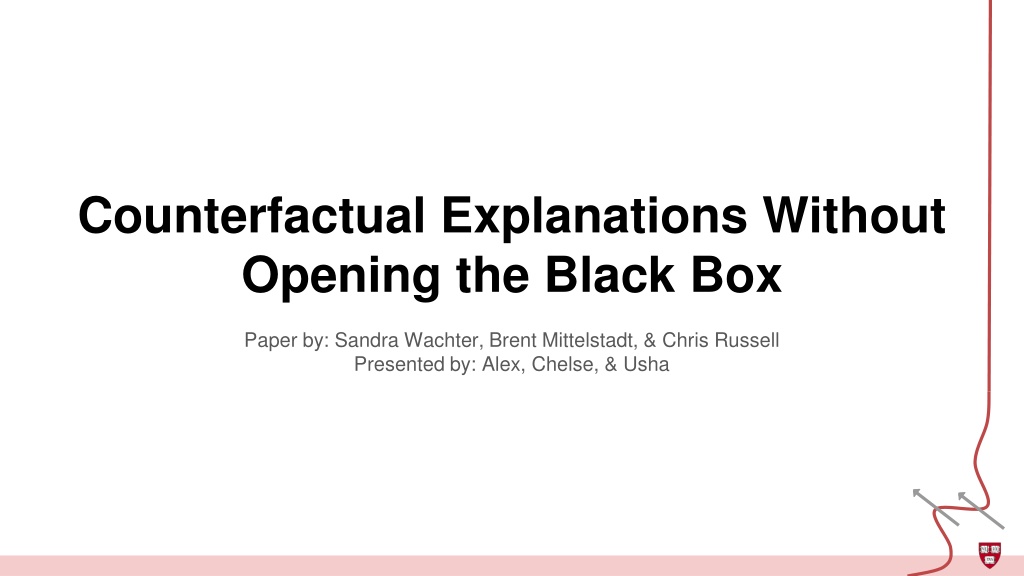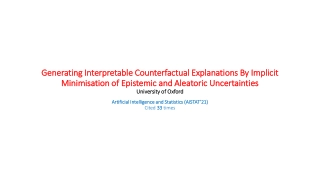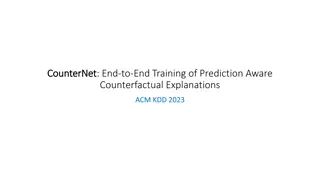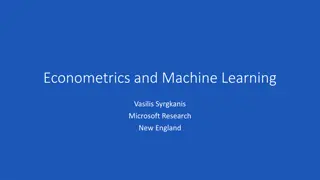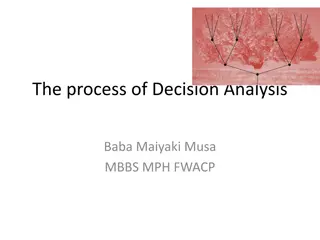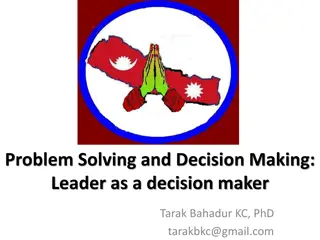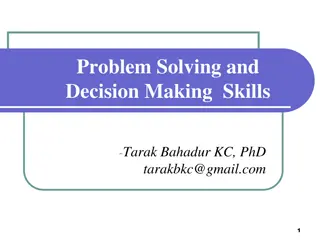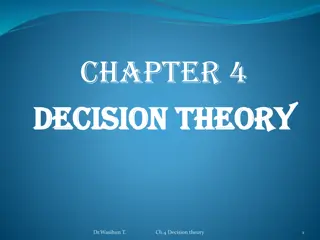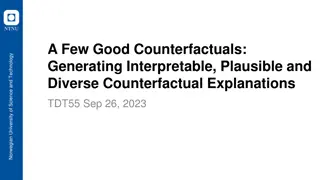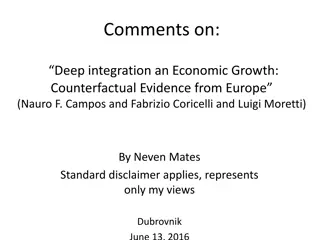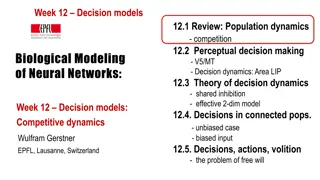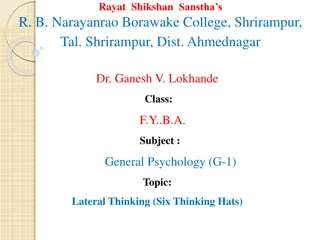Exploring Counterfactual Explanations in AI Decision-Making
Delve into the concept of unconditional counterfactual explanations without revealing the black box of AI decision-making processes. Discover how these explanations aim to inform, empower, and provide recourse for individuals impacted by automated decisions, addressing key challenges in interpretability. Uncover the definition and importance of counterfactual explanations in the context of data protection regulations and understand their role in bridging the interests of data subjects and controllers.
- Counterfactual explanations
- AI decision-making
- Interpretability challenges
- Data protection regulations
- Explainability
Download Presentation

Please find below an Image/Link to download the presentation.
The content on the website is provided AS IS for your information and personal use only. It may not be sold, licensed, or shared on other websites without obtaining consent from the author. Download presentation by click this link. If you encounter any issues during the download, it is possible that the publisher has removed the file from their server.
E N D
Presentation Transcript
Counterfactual Explanations Without Opening the Black Box Paper by: Sandra Wachter, Brent Mittelstadt, & Chris Russell Presented by: Alex, Chelse, & Usha
Introduction + Motivation EU General Data Protection Regulation (2018) 4 key problems the toughest privacy and security law in the world Article 13-14, regarding automated decision-making: meaningful information about the logic involved Recital 71: the right to obtain an explanation of the decision reached and to challenge the decision 1. 2. 3. Not legally binding Only applicable in limited cases Explainability is technically very challenging Competing interests of data controllers, subjects, etc 4.
Unconditional Counterfactual Explanations Authors propose 3 aims for explanations Inform and help the subject understand why Provide grounds to contest decisions Understand options for recourse CFEs Fulfill the above goals Overcome challenges w.r.t. current interpretability work Can bridge the gap between interests of data subjects and data controllers Do you buy this?
Unconditional Counterfactual Explanations Definition: A statement of how the world would have to be different for a desirable outcome to occur Because of features {x1, x2}, x s outcome was label y1 If x = {x1+ 1, x2+ 2}, then y2. Notes: No one unique CF Need to consider actionability (mutability of variables) Providing several diverse CFEs may be more useful than simply the closest/shortest one Example: You were denied a loan because your annual income was $30000. If your income has been $45000, you would have been offered a loan
Background + Related Work Historic context of knowledge Prior explainability work Adversarial examples/perturbations Causality/Fairness
Background: Historic Context of Knowledge In order to know something, it is not enough to simply believe that it is true: rather, you must also have a good reason for believing it If q were false, S would not believe p Note: This statement only describes S s beliefs, which might not reflect reality This statement can be made without knowledge of the causal relationship between p and q Q: who is S? The user? The model? Us?
Background: Previous Explanations in AI/ML Previously: providing insight into the internal state of an algorithm, human- understandable approximations of the algorithm Three-way tradeoff between 1. quality of approximation 2. ease of understanding the function 3. size of the domain for which the approximation is valid CFEs: Minimal amount of information Require no understanding of internal logic of model No approximation (although might not always be minimum length) Con: May be overly restrictive
Background: Adversarial Perturbations Small changes to a given image can result in the image being assigned to a different class Very similar to CFEs but the changes aren t necessarily sparse Often not human perceptible Authors propose that this is because the new images lie outside the real-image manifold Emphasize the importance of solutions/CFEs being possible as well as close Further research into structure of high-D data is structured before CFEs can be useful/reliable in those domains
Background: Causality and Fairness Can provide evidence that models/decisions are affected by protected attributes If CFEs change one s race, the treatment of that individual is dependent on race Is the converse true?
Summary of Contributions - Highlights the difficulties with conveying the inner workings of modern ML algorithms to users - Complexity - Lack of utility (except for builders ) Introduces an algorithmic approach to counterfactuals - Rooted in adversarial machine learning Connects counterfactuals to the GDPR - Demonstrates advantages over other interpretability methods from a policy perspective - -
Approach: Counterfactual Optimization Minimize: While maximizing weight on squared error term We want to have the prediction change more than we want the point to be close Iteratively: solve for x , then maximize lambda Settings: Tabular Data Regression Squared error with desired (counterfactual) label Distance to perturbed point
Approach: Distance Metrics Norms Normalizing Factors
Experimental Results: Discussion Realistic (or achievable) counterfactual values Clipping and Clamping Counterfactual Targets LSAT: Avg. Grade 0 Students would want to know how to improve their average grade PIMA: Risk Score of 0.5 Patients would want to know how to achieve a lower risk score
Explanations and The GDPR GDPR Requirements: Recital 71 Implement suitable safeguards against automated decision-making Does not require opening the black box to explain the internal logic of decision-making systems Include specific information to the data subject and the right to obtain human intervention To express their point of view Does not explicitly define requirements for explanations of automated decision-making To challenge the decision To obtain an explanation of the decision reached after such assessment
Counterfactual Explanations and The GDPR Legislators wanted to clarify that some type of explanation can voluntarily be offered after a decision has been made Many aims for explanations are feasible Emphasis of GDPR is on protections and rights for individuals
Advantages of Counterfactual Explanations Bypass explaining the internal workings of complex machine learning system Simple to compute and convey Provide information that is both easily digestible and practically useful Understanding the reasons for a decision Contesting decisions Altering future behaviour to receive a preferred outcome Possible mechanism to meet the explicit requirements and background aims of the GDPR
Explanations to understand decisions Broader Possibilities with the Right of Access Art 15. Confirm whether or not personal data used Provide information available after a decision has been made Avoid disclosing personal data of other data subjects Balance interest of the subject and controller Potential to contravene trade secrets or intellectual property rights
Explanations to understand decisions Broader Possibilities with the Right of Access Counterfactuals Data of other data subjects or detailed information about the algorithm does not needs to be disclosed Disclose only the influence of select external facts and variables on a specific decision Less likely to infringe on trade secrets or privacy
Explanations to understand decisions Understanding Through Counterfactuals Art 12(1) Requires information to be conveyed in a concise, transparent, intelligible and easily accessible form CFEs align with this requirement by providing simple if-then statements CFEs provide greater insight into the data subject s personal situation as opposed to an overview tailored to a general audience Minimally burdensome and disruptive technique to understand the rationale of specific decisions
Legal Information Gaps on Contesting Decisions Art. 16 Data subject has the right to correct inaccurate data used to make a decision, but does not need to be informed of which data the decision depended Art. 22 Data subjects do not need to be informed of their right not to be subject to an automated decision
Contesting Through Counterfactuals Lead to greater protection for the data subject than currently envisioned by the GDPR Align with Article 29 Working Party Understanding decisions + knowing legal basis is essential for contesting decisions Reduce burden on data subject Understand most influential data (instead of vetting all collected data) Compact way to convey dependencies
Explanations to Alter Future Decisions GDPR Explanations not explicitly mentioned as a guide to altering behavior to receive a desired automated decision Article 29 Working Party Provide suggestions on how to improve habits and receive better outcome Counterfactual explanations Can address the impact of changes to more than one variable on a model s output at the same time Can be used in a contractual agreement between data controllers and data subjects
Discussion Who do these explanations serve? Developers, Data subjects, and Lawmakers Do you think they are misinterpreted? Causality Optimizing for sparsity may not reflect reality Priors and desired outcomes
